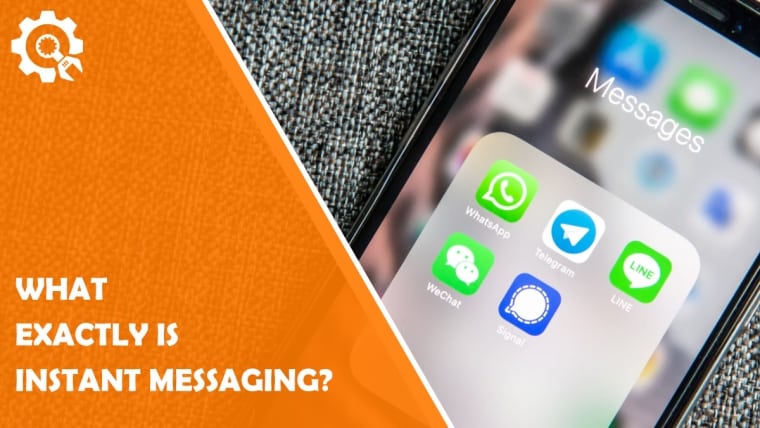Instant Messaging (IM) is a technological innovation that allows two parties to conveniently communicate via text in real-time without a distance or time barrier.
Over the years, IM has become one of the most popular forms of online communication, particularly among young people.
Today, with an instant messaging app, you can exchange text-based messages, images, and files in real-time.
It is estimated that 3.09 billion mobile phone users use instant messaging applications to communicate. The number of users is predicted to be up to 3.51 billion by 2025.
History of instant messaging
Instant messaging dates back as early as 1961 when the MIT Computation Center developed the Compatible Time-Sharing System (CTSS). Up to 30 users from MIT and neighboring colleges used it simultaneously.
This will lay the groundwork for the future of the technology.
In 1971, scientists invented EMISARI, which featured a chat function that enabled real-time messaging to aid the U.S. government during emergencies. The government used it to manage emergencies until 1986.
The succeeding year saw technological advancement, allowing many people to use IM platforms simultaneously. Typical examples are Yahoo Messenger, developed by Yahoo in 1998, and MSN Messenger, developed by Microsoft in 1999.
Yahoo Messenger, in addition to text, featured custom avatars, chatrooms, and games. On the other hand, MSN Messenger offered video calling, emoticons, and integration with other Microsoft services.
The wide adoption of instant messaging on smartphones was first facilitated by BlackBerry (BB) when it developed BlackBerry Messenger (BBM) on August 1, 2005. However, around 2009, BB had about 20 percent market share in the smartphone market. This will play a significant role in the proliferation of BBM users and the wide adoption of instant messaging for personal and business communications.
Since the invention of BBM and after the collapse of BB smartphone sales, instant messaging has continued to increase yearly.
As technology continues to evolve, the future of IM holds exciting possibilities. The integration of artificial intelligence, augmented and virtual reality could revolutionize how we connect and communicate.
Types of instant messaging
Instant messaging is usually a standalone application. It can also be part of an application that offers other functions.
For instance, Facebook Messenger is an instant messaging platform embedded in the Facebook platform.
Depending on the targeted usage, there are three types of IM apps:
Consumer-focused IM apps
Consumer-focused IM platforms develop tools usable for virtually everyone, including individuals and businesses.
People usually use these IM apps to connect with their loved ones. Typical examples are WhatsApp and Facebook messengers.
Business and collaboration tools
These IM tools contain typical IM features and allow teams and organizations to manage their daily activities effortlessly.
They contain features that allow team members to collaborate irrespective of their distance. A typical example is Spike.
Niche and specialized IM apps
Niche and specialized IM apps are designed for specific demography. They are equipped with unique features that may not be available on other types of IM apps.
Examples are Discord, designed primarily for gamers, and Signal, intended for users who prioritize privacy.
However, IM apps usually possess the following features, irrespective of the type:
- Voice over IP
- SMS
- Video chat
- File sharing
How instant messaging works
To send or receive an instant message, a user must sign into the application or navigate to the IM feature if embedded in a platform with many other features.
Once a user sign-in attempt is successful, they are instantly identified as available, while others on the platform might be alerted of their availability.
When they are signed in, the user will receive any instant message sent to them through a chat box. The technology allows users to communicate in real-time like face-to-face interactions.
Uses of instant messaging
Individuals and businesses use instant messaging applications. Therefore, the benefits differ based on the usage:
- Keeping in touch with loved ones
- Boosting staff productivity and collaboration
- Enhancing organizations’ customer service
- Enhancing education and learning
- Building communities and sharing interests
Things to consider before using instant messaging
It is not unusual to share sensitive information or secrets through IM. Unfortunately, information sent via IM is generally sent in clear text, which is vulnerable to network sniffing.
However, some platforms deploy certain technologies to encrypt users to prevent a third party from reading them.
This is why you must be sure the IM platform protects your data, especially if you use it for business.
A breach of your customers’ data privacy will earn you legal suits and erode customers’ trust in your brand.
Avoid sharing personal details, confidential information, or anything you would not want publicly accessible.
Likewise, do not click on suspicious links or download attachments from unknown contacts.
